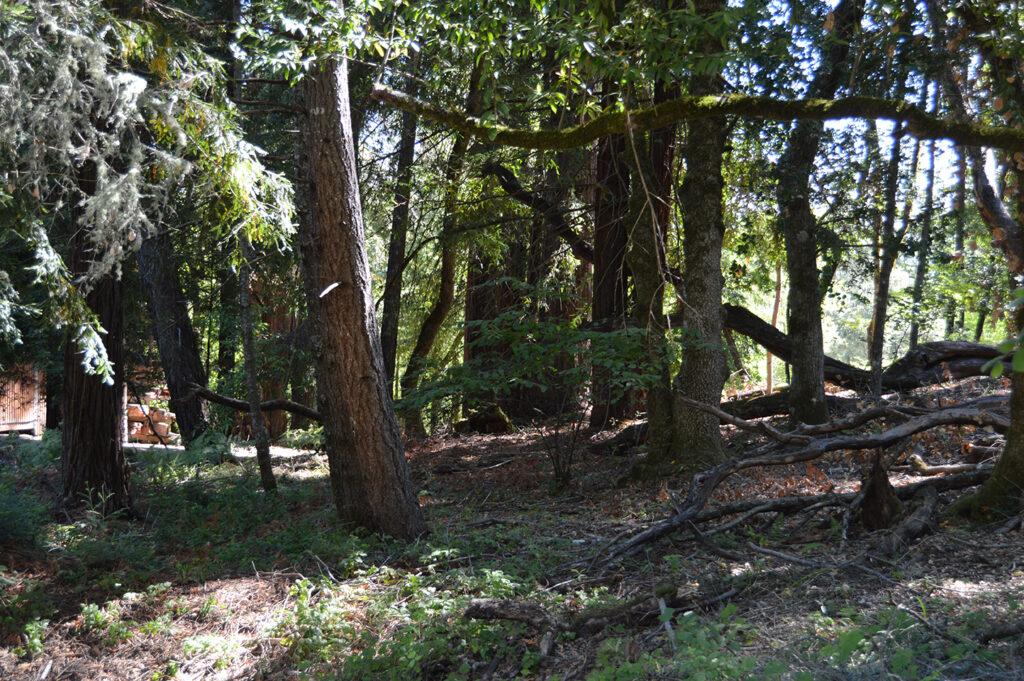
SURROUNDING WILDLANDS
A resilient landscape is fire-wise, water wise and promotes biodiversity by using California native plants. These gardens use sustainable practices, plant selection, and maintenance to reduce the risk of fire in the defensible space zone. Resilient gardens save water, protect us from fire and promote biodiversity.

Reducing risk to life and property from wildfire should be approached with the following priorities:
- First, harden the structure, as described in the House section.
- Next, establish defensible space guided by information in the Landscape tabs.
- Finally, landowners with property beyond 100’ from the home and other structures should address vegetation management conducted for multiple goals and benefits.
Wildfire likelihood and intensity can be managed while protecting and enhancing biodiversity and habitat, soil and water quality, and climate adaptation. Wildland fuel management projects often simplify vegetation patterns, but habitat complexity is very important within a fire resilient landscape. Consult an experienced restoration or forestry specialist before initiating any wildland vegetation management project.
Tending the Land
Tending the Land for Fire Resilience in Sonoma County is a website guide for anyone who plays a role in stewarding land in Sonoma County to achieve a variety of goals, from fire resilience to conserving water, enhancing wildlife habitat, and more.
While Sonoma County is full of experts in land management, this expertise has been scattered and overwhelming for users until Tending the Land summarized it in one easily accessible and understandable resource.
Distilling deep regional expertise into a step-by-step process for planning and caring for the land, the new website explains in plain language how to achieve multiple land stewardship objectives over time.
Anyone who stewards land can use this resource, from landowners, volunteers, and non-profit organizations that help care for open space, to land management professionals. Because of its accessible language and format, the new resource bridges the gap between professionals and the public.
Among many useful topics covered by Tending the Land include the benefits of forest thinning, prescribed fires, case studies of successful ecological land management, and Indigenous land gardening knowledge.
This project was accomplished through joint efforts among Sonoma Ecology Center, Pepperwood, Occidental Arts and Ecology Center, and dozens of contributors from organizations including CAL FIRE, Resource Conservation Districts, Sonoma Land Trust, LandPaths, Permit Sonoma, UC Cooperative Extension, and Indigenous knowledge holders.
Resources
Our outreach around creating and maintaining defensible space has generated many questions about management of surrounding wildlands. Members of the Resilient Landscapes Coalition responded by partnering with other land management experts to create a number of workshops and other resources:
Beyond Defensible Space: A Deep Exploration into Wildland Fuel Management is a video of our presentation to the West Sonoma County community, June 1, 2022.

Beyond Defensible Space featuring Lightning Consultations is a video of a July 27, 2022 webinar that brought together land management experts to discuss real resource conservation issues on real Sonoma County properties.
Resources for Land Owners and Managers is a document with many useful links to land stewardship resources.
The University of California’s Forest Stewardship Program is a fantastic resource for landowners with larger properties.
Tending the Land for Fire Resilience in Sonoma County is a website guide for anyone who plays a role in stewarding land in Sonoma County to achieve a variety of goals, from fire resilience to conserving water, enhancing wildlife habitat, and more.